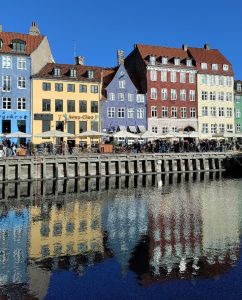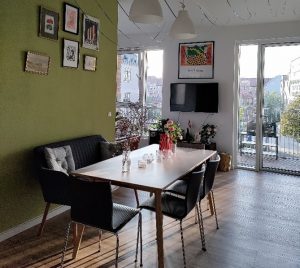Student at the Faculty of Science
Before the exchange
Already when I started my master studies, I was sure that I wanted to go on exchange during the degree. I was on an exchange also during my bachelor studies and I wanted to take the opportunity to go again. This time, I was looking for an Erasmus exchange, where they had interesting courses within the subject of Urban planning. I ended up going to Aalborg University, Copenhagen campus, to study Sustainable Cities.
Pretty much the only thing I had to do before going to Denmark was to send my application and learning agreement to the university, notify the change of address, get my travel insurance extended with a month and search for housing.

Arriving in Denmark
I arrived in Copenhagen about a week before the university started, which was nice, as it allowed some time to get settled in, get to know the city and my new roommates. In contrast to my earlier exchange there weren’t really any welcoming parties or similar. But I also think I had a bit of a different Erasmus experience than most, so there might have been some more exchange student events in other universities in the city.
Most people I have met love the city and so did I. I had already been to Copenhagen before, so it was a bit familiar. I also speak Swedish, so getting the hang of everyday life was not that hard, as I understood every sign and instruction in the city. Even though it is different from Finland, it is still a Nordic country, and I didn’t experience any culture chocks or problems to adapt.
Overall, when I arrived, I had no bureaucratic things to worry about, which was heaven compared to my exchange outside the EU. As Denmark is a Nordic country and I didn’t stay longer than six months, I didn’t have to get a Danish CPR-number or register like the rest of the international students. It was almost too easy.
First week of university was a lot of fun. The first day was for the international students, which there were a LOT of. The second day I got to meet my amazing classmates and teachers, and even though we were the only program who had no tutors showing up on the welcome day, everyone was keen on getting to know each other and hanging out.
What I immediately noticed was that I was the only exchange student in my class. I also found out that I was one out of five exchange students in the entire Copenhagen campus of my university. This scared me at first as my experience from my previous exchange as well as the stories I had heard about Erasmus, all put a lot of weight on meeting other exchange students. However, this was not a problem at all. As I mentioned, there were a lot of international students at the university, about 50% in my class where international students and 50% were Danes, so there were a lot of people that were new to the city. Most of the Danes knew each other from their bachelor’s degree at Aalborg University, but they were all very interested to get to know all the international students.
Housing
I would say that housing was the thing I stressed about the most before going to Copenhagen. Finding an apartment as an “outsider” is very hard, and especially in Copenhagen, finding a room or flat with a reasonable price is not easy.
Overall Copenhagen is more expensive than Finland, so if you want to live in the city-center you should be ready to pay a little bit more than at home. Also finding studio apartments is quite hard, however I wanted to live with other people and ended up in a student housing with Danes and Americans.
My room in a 5-person student-apartment, including everything, ended up costing 520 €/month, which was a very good price for Copenhagen.
Most students live in shared flats or kollegiums. The kollegiums are student housing and are a lot cheaper than the normal apartments. Normally you would have your own room and toilet and then share the kitchen with maybe 15 other people. The kollegiums are however challenging to get as you don’t have the time to wait in the queue for them very long, however, you can try to sub-renting them, as I did.
I started with applying for housing through the university. I got one room pretty quickly but decided to decline the offer as the apartments were not even in the city. If you are staying in Copenhagen for a longer time and don’t want to put money on living in the city, this would be a good option, but as I was there for such a short time, I wanted to be closer to everything, a decision I do not regret.

I started looking for apartments on Facebook maybe 3 months before the exchange and I probably sent a message to over 70 people. As the number of messages these Facebook posts get is so high, I only ever got replies from about 10. I would not say that this is a very good way to go, but in my case, I saw it as the only option. In the end I got in contact with someone through a friend that lives in Copenhagen. He was going on exchange during the time I was there, so it was perfect. This was about a month before I flew to Denmark.
I think the best chance to get a good place is to actively look into different Facebook groups and specifically search for people that are going on exchange, as these are more likely to take someone that is coming for a short time. The absolute best chance is if you have contacts in Denmark. I would really recommend contacting them just to keep ears and eyes open if something comes up.
As a backup plan I was looking at hotels where you could rent rooms monthly, I think it would have been about 800 €, but it would have given some time to find something once I had arrived. Because once you are in Denmark and know some people there, it gets a bit easier to find something.
Everyday Life
Everyday life in Denmark was pretty much the same as in Finland, but I guess everything is a bit better on exchange. Copenhagen is an amazing city and in my free time I explored the city with other international students, went to try different restaurants, cafés and bars with my classmates and hung out with my roommates. In Copenhagen they also have very good bakeries and taprooms that are worth trying out.
One thing that surprised me was that every University had their own bar. So, Friday bar, after you finished your week of studying, was a very popular thing. They also organised a lot of fun events at the university. As I mentioned earlier, my Erasmus experience was perhaps not what I expected. I know that Erasmus organised a lot of fun activities during the week, but as none of my friends were a part of the exchange programme, I never went to any of them. And as there were only a few exchange students in the university, we just counted as internationals, and most people even forgot that I was going home after the semester.
The living cost for everyday life was kind of hard to follow as the currency was different. The grocery store prices were perhaps a bit more expensive than in Finland. Alcohol was a bit cheaper than in Finland but overall, pretty much the same.
Studying
Aalborg University is a very good university, and I actually found the university courses at Aalborg University to be quite different from the ones in Finland. First of all, Aalborg University had something called Problem Based Learning, or PBL. This was not exactly new to me, as I feel like the way some of the courses at home had a bit of the same structure, but it was definitely more established at Aalborg. I really like this approach as it made the studies feel a bit more connected to real life and gave some more practical learnings. Overall, the amount of work was pretty similar to my studies at the University of Helsinki.
Another big difference was that the courses were settled for the programme and there was no freedom in the choosing of courses. Hence, you need to be aware that the courses you put on your learning agreements are the only courses that are offered during that semester, and the ones you have to take. As I didn’t want to take the methodology course that was obligatory for the rest of the class, as they were going to get the degree from that programme, my only way to not take it was to fail it. This however was not a problem as the University of Helsinki only requirement was for me to take 25 credits, which I took.
The exams at Aalborg were oral exams, which was something completely new for me. All my courses were built the same way, there was a group project and for the exam we went together with the group into the oral exam. There was always a short presentation of the group work and then a discussion with the teachers. During the discussion, the teachers were asking questions, about the group project and sometimes about other things from the course. Even though it might seem horrifying to have an oral exam if you have never been to one before, it was more like a discussion, and you always had your group by your side. I don’t know if I particularly liked to have oral group exams as it doesn’t really show individual strengths and weaknesses, however it is good preparation for the future.
The semester was from September to January, where January was the exam period, meaning that the spring-semester in Finland and the exam period went on top of each other. For me this only meant a delay in the starting of my thesis, but as I had no courses in January it was fine. There was one vacation in the autumn and of course Christmas holiday.
After returning to Finland, I only needed to upload the documents to my Mobility Online account and get my credits transferred in Sisu.
Other things worth mentioning
I chose not to open a Danish bank account as I was staying there for such a short time. However, as I did not need to pay my rent directly to a landlord, I was able to organise the payment through normal bank transfers, without any extra costs (SEPA-payments). If you are in a situation where you have to do many foreign currency payments, getting a bank account might be to your benefit.
To get the real Danish experience, especially in Copenhagen, you need to have a bike, as the Danes bike everywhere. The city is flat, and the bike-roads are great. It felt a bit stressful in the beginning, but you learn quite quickly when you follow others, and it makes your life in Copenhagen ten times easier and more fun. I biked 10 km every single day to get to school and back, even in rain, which I never would have done in Helsinki. I would recommend either buying or renting a bike. I rented one from a company called Swapfiets, which is very popular in Copenhagen, and you will see their blue tires everywhere.


